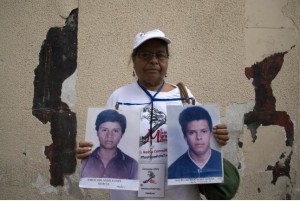Migrant tragedy unfolding in secret
While the migration crisis in Europe and the Middle East has received blanket media coverage for more than four years, a new refugee tragedy is quietly unfolding in Central America.
The United Nations High Commission for Refugees (UNHCR) has reported a near five-fold increase, since 2008, in asylum-seekers arriving to the United States from the Northern Triangle region of El Salvador, Guatemala, and Honduras.

Clementina Murcia González, from Honduras, holds up the pictures of her two missing sons, Jorge Orlando Funes Murcia and Mauro Orlando Funes
Many refugees, however, don’t make it because these countries have some of the world’s highest murder rates.
There is a global trend of people being forcibly displaced — by the end of last year more than 60 million people had been forced to flee their homes as a result of persecution, conflict, violence, or human rights violations.
But the plight of the displaced in Central Americans is particularly dire. Although no official figures exist, it is reported that at least 70,000 migrants and refugees have gone missing in Mexico since 2006.
They are mostly people fleeing crime gangs, regional conflict and war lords to seek a new life in the US.
But the figure of 70,000 is just a guess at the numbers who have perished because no one is actually counting, or identifying the dead.
In response to the hundreds of thousands who have gone missing a movement has sprung up called Movimiento Migrante Mesoamericano – or ‘caravan of mothers’.
The organisation’s spokesman Rubén Figueroa says there are graves all along the migrant route.
“There is no database, no information banks. For the families, these people have simply disappeared,” Mr Figueroa says.
“No one knows what happened to them, because there is no official count, no official procedure to have them identified – this is a policy of not counting, of not wanting to know what is happening to the people on the migrant route. It’s very hard to understand, but it’s a reality.”
The typical person making the trek has changed drastically in the last few years, the UNHCR report says.
Where once they were single young people, now they are entire families, mothers with children, young women who are pregnant, unaccompanied children and teenagers – and even senior citizens.”
The number of women with children escaping violence in El Salvador, Honduras, and Guatemala is rising, the UNHCR reports. In 2014, more than 66,000 families travelled to the United States from Mexico and the Northern Triangle region.
“Many leave because they are being extorted; others are being threatened. They have no other choice. If they are to save their lives, they have to migrate,” , Rodríguez Cartagena explained,” Mr Figueroa says.
“But there is no safety anywhere. If they leave their countries, looking for a better life, they come through Mexico, and here they find death,” he says.
“In our continent, the dead are in the thousands. We may not have bombs going off, but blood is shed all the same. This is a context of undeclared war.”
Observers and activists say government policy is turning migrants into prey for criminal gangs. Mexico’s Frontera Sur program is a prime example they say.
Aiming to stem the flow of Central Americans entering the United States, President Enrique Peña Nieto introduced the initiative in July 2014. Under the program, Mexico increased checkpoints, tightened border controls, and used troops to actively discourage migrants from riding ‘The Beast.’
In 2015, Mexico deported 178,254 people, most of them Central Americans on their way to the United States, the highest total since 2006.
Mexico estimates that some 300,000 migrants pass through its territory yearly, with nearly 200,000 detained in transit during 2015.
Unable to get on the train, or ride the highways, now sprinkled with checkpoints, migrants have been forced to travel along alternate routes, making them more vulnerable to kidnappings, rapes, extortion demands, and murder.
“This is a policy of persecution,” Mr Figueroa says. “It hides migrants, it forces them to flee into the hills, it makes them invisible, and it makes them vulnerable to organized crime.”
The number of Central Americans reaching the United States did fall, but complaints of abuse at the hands of Mexican officials shot up around 40 per cent, according to reports by news agency Reuters.
“So long as the migrants are forced to disperse and pursue other means, they are left unprotected, exposed to whatever they find on the road,” said Marta Sanchez Soler, who leads Movimiento Migrante Measoamericano.
The ‘caravan of mothers’ website tells the story of Clementina Murcia González who joined the group in search of her two sons Jorge and Mauro.
Jorge left at 17 with her permission but Mauro didn’t ask if he could go, he just went.
Both went missing, lost somewhere in Mexico, as they made their way to the United States from Honduras.
Clementina was one of some 40 Central American mothers who took part in a caravan travelling through southern Mexico, visiting prisons, shelters, as well as other spots along the migrant route, looking for missing sons and daughters.
“We are worth nothing,” she says. “For many people, we are worth nothing.”
Laurie Nowell
AMES Australia Senior Journalist












